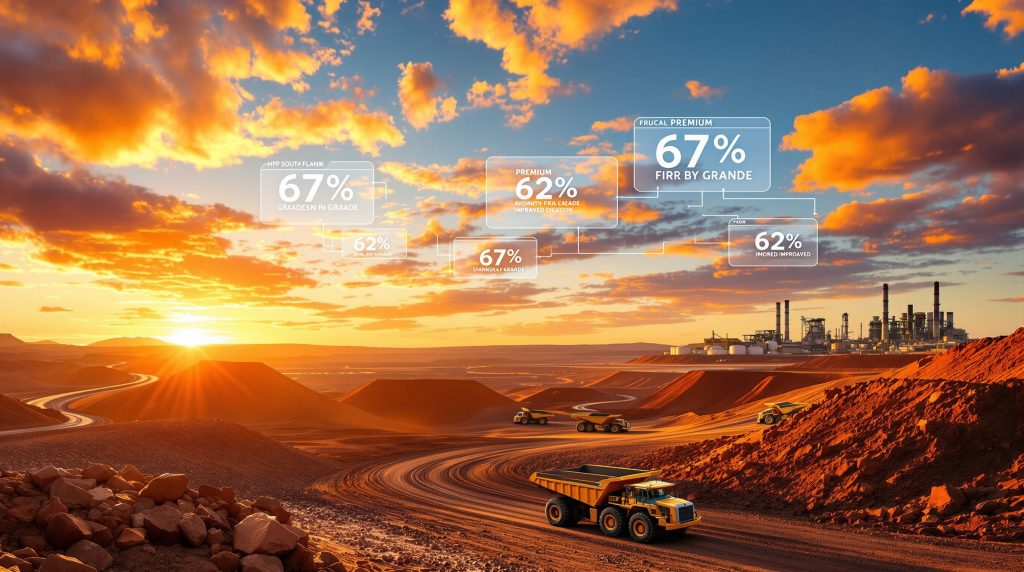BHP Gears Up for Higher Iron Ore Grades: Strategic Positioning in a Changing Market
BHP, one of the world's largest iron ore producers, is strategically repositioning itself to capitalize on the growing demand for higher-grade iron ore. This shift comes amid the global steel industry's transition toward greener production methods that require premium ore qualities. The mining giant's recent operational performance and strategic investments signal a clear direction toward quality over mere volume, setting the stage for long-term competitive advantage in an evolving market landscape.
Recent production figures show BHP's Western Australia Iron Ore (WAIO) operations achieved record output of 257 million tonnes in the 2024-25 financial year, with the company's total production reaching 290 million tonnes on a 100% basis. This exceptional performance, despite weather-related challenges including cyclone disruptions, demonstrates BHP's operational resilience and efficiency improvements across its Pilbara operations.
What's Driving the Demand for Higher-Grade Iron Ore?
The Decarbonization Imperative in Steel Production
The global steel industry faces mounting pressure to reduce carbon emissions, with traditional blast furnace operations typically generating around 2 tonnes of CO₂ for every tonne of steel produced. This environmental challenge is driving a fundamental shift in production technologies, with direct reduced iron (DRI) processes emerging as the most commercially viable pathway to lower-carbon steelmaking.
This technological transition is transforming raw material requirements across the value chain. While conventional blast furnaces can efficiently process iron ore with 62-63% iron content, DRI facilities demand significantly higher grades—typically 67% iron content or above—with substantially lower impurity levels. This quality requirement stems from the DRI process's inability to produce slag that would otherwise remove impurities, meaning any contaminants in the iron ore remain in the final product.
Market Premium for Quality
The market has responded to this quality divergence with expanded price differentials between standard and premium-grade products. High-grade iron ore with 65% iron content or above commands significant premiums, reflecting both its scarcity and strategic importance in emission reduction efforts. Industry data indicates that less than 30% of global iron ore production meets this premium standard, creating structural support for sustained price forecast insights.
For producers like BHP, this evolving market dynamic creates compelling incentives to invest in quality enhancement rather than simple volume expansion. Steelmakers increasingly evaluate iron ore purchases based on total value in use—considering factors such as productivity improvements, emission reductions, and energy savings—rather than basic price per tonne, justifying premium pricing for superior products.
South Flank: BHP's Quality Game-Changer
Record-Breaking Performance in First Full Year
BHP's South Flank mine has emerged as the cornerstone of the company's quality enhancement strategy. This $3.6 billion development, which achieved first ore in 2021, has exceeded expectations in its first full year of operation, surpassing its nameplate capacity of 80 million tonnes. The mine's performance has been instrumental in offsetting weather-related disruptions elsewhere in BHP's production system while delivering significant quality improvements.
South Flank's contribution to BHP's product portfolio has been transformative, increasing the company's average iron ore grade from 61% to 62% while boosting the proportion of premium lump ore from 25% to 30-33%. These improvements translate directly into pricing advantages and enhanced customer satisfaction, particularly among Chinese steelmakers who value the operational benefits of higher-grade materials.
Strategic Location and Infrastructure Integration
The mine's integration with existing infrastructure at Mining Area C creates what is now the world's largest operating iron ore hub, capable of producing 145 million tonnes annually. This scale provides operational efficiencies and logistical advantages while ensuring consistent supply of high-quality products to global customers who increasingly prioritize reliability in their raw material sourcing strategies.
South Flank's 25-year operational life provides BHP with sustainable access to high-quality ore reserves that will support the company's participation in premium markets as global steel production transitions toward lower-emission technologies. The mine's ore characteristics align well with evolving market types and deposits, creating optionality for BHP to serve different customer segments with varying quality specifications.
How Is BHP Enhancing Ore Quality Through Technology?
Beneficiation Initiatives at Jimblebar
Beyond South Flank's natural high-grade characteristics, BHP is pursuing technological solutions to upgrade lower-grade materials through strategic beneficiation investments. The company is studying options to build beneficiation plants at its 60-million-tonne-per-year Jimblebar mine to improve ore quality that currently trades at approximately $20 per dry metric tonne discount to standard 62% iron content benchmarks.
The Jimblebar beneficiation project aims to upgrade Jimblebar Blend Fines from their current 60.5% iron content to levels that eliminate or significantly reduce pricing discounts, creating substantial value through technological intervention. Technical feasibility studies indicate favorable ore characteristics that make this investment commercially attractive, with construction and commissioning works planned over a two-year timeframe.
Overcoming Technical Challenges
BHP's beneficiation development efforts acknowledge the technical limitations inherent in processing Pilbara ores compared to magnetite deposits found elsewhere globally. Many Pilbara ore deposits exhibit weaker magnetism and density differentials between iron and impurities, making them less responsive to traditional beneficiation methods that rely on these physical properties.
Despite these challenges, BHP has achieved significant progress in demonstrating the commercial viability of its iron ore products in premium applications. Through collaborative research and development programs with customers operating pellet plants in China, BHP has successfully shown that WAIO products can be blended with various ore types to produce pellets suitable for both blast furnace and direct reduced iron applications.
What Are the Market Dynamics Supporting BHP's Strategy?
Chinese Demand Patterns and Policy Influences
China's steel industry, representing approximately 60% of global production, continues to drive iron ore price trends while undergoing its own transformation. The country's commitment to peak steel production by 2030 and increase scrap steel use to 320 million tonnes by 2025 creates complexity in raw material planning, as steelmakers balance traditional operations with emerging low-carbon technologies.
Recent market conditions have supported premium pricing, with BHP noting that the market was supported most recently by the elevated blast furnace run rate in China and several disruptions to iron ore supply, including weather-related impacts to seaborne supply and the extended impact of safety inspections at Chinese domestic iron ore mines. Depleted Chinese stocks have contributed to a 12% price increase since early May 2025.
Emerging Competition from Simandou
BHP expects new market dynamics with the entry of higher-grade supply from the Simandou project in Guinea, where first tonnes are expected by the end of 2025. The company anticipates these volumes will primarily produce higher grade fines, rather than mid-grade brackets, like those from the Pilbara, potentially reshaping competitive dynamics in premium market segments.
This evolving landscape makes operational excellence increasingly critical, with BHP noting that these evolving market dynamics will make it even more important to create competitive advantage and to grow value through driving exceptional operational performance. The company's cost position provides crucial flexibility, with C1 costs of $15-18 per wet metric ton substantially below industry averages.
What Is BHP's Production Outlook and Market Positioning?
Strong Production Guidance for FY2026
Looking ahead, BHP has established ambitious production guidance for fiscal year 2026, targeting 284-296 million tonnes of iron ore production, representing a potential 2% year-over-year increase. This guidance reflects management's confidence in continued operational improvements, stable market conditions, and the strategic benefits of ongoing investments in mine optimization.
The company estimates cost support for seaborne supply sits at $US80–100 per tonne cost and freight (CFR), with about 180 million tonnes of higher-cost production under pressure at the top end of that range. This market structure provides pricing stability while creating opportunities for efficient producers like BHP to capture market share from marginal suppliers during cyclical downturns.
India's Emerging Importance
BHP also expects India to be an "opportunistic importer" during periods of domestic supply disruption, potentially creating additional demand insights. India's projected quadrupling of steel demand over the next quarter-century provides another significant growth market for high-quality iron ore, particularly as the country develops its industrial infrastructure while prioritizing environmental sustainability.
How Does BHP's Iron Ore Strategy Fit with Its Broader Portfolio?
Diversified Commodity Exposure with Strategic Focus
BHP's iron ore quality enhancement strategy complements its broader portfolio positioning across key commodities essential for global economic development and energy transition. The company noted that despite these dynamics, demand for BHP's commodities has been resilient and in the case of copper, demand has been higher than previously expected, highlighting the complementary nature of its diversified asset base.
The company's Steel Decarbonisation Framework recognizes three distinct phases of industry evolution: Optimization, Transition, and Green end state, with each phase creating different opportunities for iron ore suppliers. BHP's investments in quality enhancement, operational efficiency, and customer collaboration position the company to capitalize on opportunities across all phases while building sustainable competitive advantages.
What Challenges Does BHP Face in Its Iron Ore Quality Strategy?
Technical Limitations and Economic Trade-offs
Despite BHP's strategic advantages, the company faces several challenges in its pursuit of higher-grade iron ore production. The economic dynamics of beneficiation create complex trade-offs between grade improvement and iron recovery that must be carefully evaluated in investment decisions. As beneficiation targets are pushed toward higher grades, iron is lost in rejected waste at accelerating rates, reducing overall mine production and potentially eroding financial returns.
Most Pilbara operations face a ceiling on achievable product grades even with best available beneficiation technology, creating practical limitations on extreme grade enhancement. This reality requires BHP to balance quality improvements with production volumes and capital efficiency to optimize overall financial performance while meeting evolving customer requirements.
Competitive Pressures and Market Evolution
The entry of new high-grade supply from projects like Simandou will intensify competition in premium market segments, potentially compressing price differentials between standard and high-grade products. BHP must continue advancing its technical capabilities and customer relationships to maintain competitive advantage in this evolving landscape while demonstrating the superior value proposition of its products through technical performance data and collaborative development initiatives.
Conclusion: BHP's Strategic Positioning for the Future of Iron Ore
BHP's strategic focus on higher iron ore grades represents a forward-looking response to fundamental changes in global steel production technologies and environmental requirements. The company's investments in South Flank, beneficiation technology, and operational excellence position it advantageously in a market increasingly dominated by quality considerations rather than simple volume metrics.
The successful ramp-up of South Flank, exceeding its nameplate capacity in its first full year of operation, validates BHP's investment thesis while providing immediate quality improvements across the company's product portfolio. Ongoing beneficiation initiatives at operations like Jimblebar demonstrate BHP's commitment to technological solutions that can overcome natural resource limitations and create sustainable competitive advantages.
As the global steel industry continues its transition toward lower-emission production technologies, BHP's strategic positioning in premium iron ore segments provides both immediate financial benefits and long-term optionality. The company's balanced approach to volume, quality, and cost optimization creates resilience in volatile market conditions while establishing the foundation for sustained value creation in an evolving iron ore landscape.
FAQs About BHP's Iron Ore Strategy
What percentage of BHP's iron ore meets premium grade specifications?
With the addition of South Flank, BHP has increased its average iron ore grade from 61% to 62%, while boosting the proportion of premium lump ore from 25% to 30-33%. The company continues working to increase the percentage of production meeting premium specifications through both strategic mine development and technological beneficiation.
How does the Simandou project affect BHP's market position?
BHP expects the Simandou project in Guinea to primarily produce higher-grade fines rather than mid-grade products typical of the Pilbara region. This will introduce new competition in premium market segments, making operational excellence and customer relationships increasingly important for maintaining competitive advantage.
What is driving the price premium for high-grade iron ore?
The transition toward lower-emission steel production technologies, particularly direct reduced iron (DRI) processes, requires iron ore with 67% iron content or higher and significantly lower impurity levels than traditional blast furnace operations. This quality requirement, combined with limited global supply of such premium materials, supports sustained price premiums.
How is BHP addressing the technical challenges of beneficiation?
BHP is investing in advanced beneficiation technologies tailored to the specific characteristics of its Pilbara ores, which exhibit different physical properties than magnetite deposits found elsewhere. The company has also demonstrated through collaborative research that its products can be successfully used in premium applications through appropriate blending and processing techniques.
What is BHP's production guidance for fiscal year 2026?
BHP has established production guidance of 284-296 million tonnes for fiscal year 2026, representing a potential 2% year-over-year increase from its record 2025 production of 290 million tonnes. This guidance reflects confidence in continued operational improvements and the strategic benefits of ongoing investments in mine optimization.
Further Exploration:
Readers interested in learning more about the iron ore market and BHP's operations can also explore related educational content at Australian Mining's website, which offers additional perspectives on industry leader advantages.
Ready to Discover Major ASX Mineral Opportunities Before the Market?
Discovery Alert's proprietary Discovery IQ model delivers real-time alerts on significant ASX mineral discoveries, instantly empowering you to identify actionable trading opportunities in commodities like iron ore. Explore our dedicated discoveries page to understand how historic mineral discoveries have generated substantial returns for early investors.




